Picture the Smell
To pinpoint smells, an electronic nose turns scents into colorful data.
By Sarah Webb
Just a whiff of steaming pizza straight out of the oven is enough to make your mouth water.
Your nose is a living sensor that responds to the chemicals in pizza that give this food its distinctive aroma. Your brain recognizes this combination of odors almost instantly.
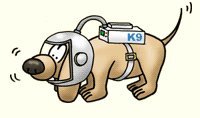 |
|
Dogs have a much better sense of smell than people do. To make it easier for people to detect and identify odors, chemists have invented electronic noses. |
| NASA |
How does your brain do it? It processes the mixture of chemicals that make up a smell as a pattern and then matches that pattern to one that you’ve already stored in your brain. The particular mix of compounds that gives fresh bread, tomato, garlic, and cheese their aroma, for example, means pizza.
But compared with dogs, people aren’t very good at identifying smells. So, chemists are designing sensors—electronic noses—that help people do this job better.
Electronic noses can go where human noses shouldn’t. For example, some electronic noses can sense substances that would be harmful to humans. Other electronic noses can sense chemicals that people can’t detect at all. Researchers have even built an electronic nose to send into space.
Color patterns
Scientists have been designing and building electronic noses for more than 20 years.
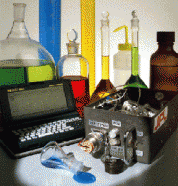 |
|
An electronic nose developed by NASA researchers can detect hazardous gases in the air on spacecraft. |
| NASA |
One such device looks a bit like a computer chip covered with neat rows of dots. Each dot contains a chemical dye.
“We use anywhere from 20 to 36 different dyes that change color depending on what chemical they’re exposed to,” says Ken Suslick. He’s a chemist at the University of Illinois at Urbana-Champaign.
Some of the dyes are made of materials that change color to show how acidic or basic a chemical is. If you’ve ever used litmus paper, you know how this works. This paper contains a dye that turns red for an acid, such as lemon juice, or blue for a base, such as baking soda.
To use their nose-on-a-chip, Suslick and his coworkers expose it to chemicals that they’re interested in. The chips can detect chemicals in liquids as well as in solids. A scanner detects any color changes that occur after exposure.
The resulting color pattern is like a chemical fingerprint. Each pattern is unique to a single odor or mixture of odors, Suslick says.
Connecting the dots
To find out what the colored dots mean, chemists need a reference library that contains the patterns created by compounds responsible for the smells of different substances.
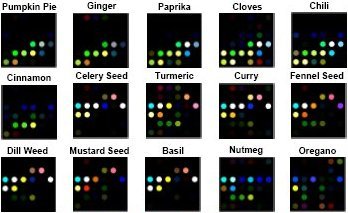 |
|
Each spice and herb has a distinctive smell and produces its own fingerprint of colored dots. |
| ChemSensing |
Your brain already holds such a library. You collect smells all your life, and whenever you sense an odor, your brain tries to connect it with one that’s already familiar to you.
“So, if you smell something, you can almost hear the gears in your brain clicking, saying, ‘Gee, what does that smell like?'” Suslick says. “And you’re sort of going through a list in your head. That’s the library.”
When your brain makes a match, it identifies the smell.
To build a library for his electronic nose, Suslick has exposed the chip to many substances and recorded the resulting patterns of colored dots. With such a collection of patterns in his library, he can then compare the colors produced by a known substance with what he sees for an unknown material.
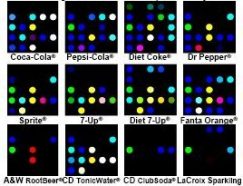 |
|
Ken Suslick’s nose-on-chip can detect different brands and types of soda. |
| ChemSensing |
Chemicals in space
Electronic noses can also alert people to hazards. On the space shuttle or in the International Space Station, for example, a chemical leak could mean a problem with the spacecraft or danger for the crew. Detecting such leaks promptly is essential.
So, NASA researchers are working on the design and testing of an electronic nose, which they call the ENose. They hope that ENose will one day monitor the inside of a spacecraft to make sure that there aren’t any chemical leaks, says Amy Ryan. She’s a chemist at NASA’s Jet Propulsion Laboratory in Pasadena, Calif.
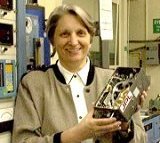 |
|
Amy Ryan holds an early version of ENose. |
| NASA |
ENose uses a set of four chips, each of which has eight sensors. Each sensor consists of a thin plastic film that expands or contracts, depending on the compounds in the air. The reactions of the individual films create a pattern. Like the human brain, the ENose is programmed to recognize these patterns and smells.
Once it’s in place on a spacecraft, ENose will run 24 hours a day, 7 days a week, monitoring the air to make sure that dangerous substances, such as mercury, or coolants, such as Freon, aren’t present in the cabin.
NASA tested an early version of the device for 6 days on a space shuttle mission in 1998, Ryan says. Now, they’re gearing up for a 6-month test on the International Space Station, planned for 2008.
Although the sensors are finished, Ryan is still working on the chemical library and the software that will keep the ENose running in space. She won’t be on the space station with the ENose, so the ENose will send information from the space station to her computer in California.
But even this sensitive space sensor can’t compete with a dog’s amazing ability to detect and identify smells. Electronic noses still have a long way to go to top a dog’s sniffer.
Going Deeper:







